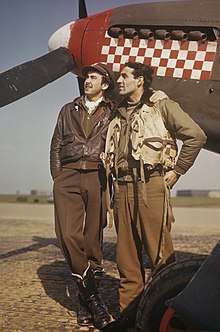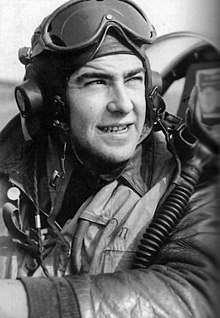John T. Godfrey
| John Trevor Godfrey | |
|---|---|
 | |
| Nickname(s) | Johnny |
| Born |
March 28, 1922 Montreal, Canada |
| Died |
June 12, 1958 (aged 36) South Freeport, Maine, U.S. |
| Buried |
Maple Root Cemetery Coventry, Rhode Island |
| Allegiance |
Canada United States |
| Service/ |
Royal Canadian Air Force (1941–43) United States Army Air Forces (1943–46) |
| Years of service | 1941–1946 |
| Rank | Major |
| Unit |
336th Fighter Squadron 4th Fighter Group |
| Battles/wars | World War II |
| Awards |
Silver Star (2) Distinguished Flying Cross (8) Purple Heart Air Medal (4) |
John Trevor Godfrey (March 28, 1922 – June 12, 1958) was an American fighter pilot and flying ace in the 336th Fighter Squadron, 4th Fighter Group, Eighth Air Force during World War II.[1] He was credited in shooting down sixteen enemy aircraft in the air and destroying another thirteen on the ground, during World War II. He later served in the Rhode Island Senate.
Early life
Godfrey was born on March. 28, 1922 in Montreal, Canada, the youngest of four boys born to British parents. When he was a year old, the family moved to Woonsocket, Rhode Island. After graduation from high school in 1941, Godfrey went north to Canada and made several attempts to join the Royal Canadian Air Force but his mother notified the FBI and he was arrested twice for violation of the Neutrality Acts of the 1930s.[2]
Finally his parents agreed to let him go and he joined the RCAF in August 1940. They agreed that if he did not become a pilot he would return to Rhode Island and go to college.
Military Career
In October 1941, Godfrey headed off to New Brunswick and initial military training. Heresumed and completed military training and the No. 3 Initial Training School course in the spring of 1942. Upon getting to secondary flight school, he contracted Whooping cough and again missed several weeks of class. He joined class #11 upon recuperating and graduated in October 1942. He was now a sergeant pilot in the RCAF and was sent overseas.[3]
World War II
After arriving in England, he learned he had received a commission and been promoted to Pilot Officer in August. Assigned to the 57th Operational Training Unit, Godfrey would ultimately complete his training and receive his transfer to the United States Army Air Forces. Upon transferring he became a Second Lieutenant in the USAAF. Finally in September 1943, Godfrey received orders posting him to RAF Debden and the 336th Fighter Squadron of the 4th Fighter Group. He flew his first mission on September 27 as a wingman to Captain Don Gentile.[4]

Soon he was a regular on operations. He flew an aircraft bearing the legend "Reggie's Reply". There were several planes with this title in the 4th Fighter Group at that time. All of Godfrey's fighters – a P-47D and P-51B – bore this name. It was named in honor of his brother Reggie, who was killed when the ship he was travelling, SS Vancouver Island was torpedoed by a German U-Boat off the coast of Greenland, killing all 105 people on board. He was then part of the Civilian Technical Corps, going to help man the expanding radar network in England. [5]
On December 1st, he would shoot down his first enemy aircraft, an Me-109, while flying the Republic P-47 Thunderbolt. On the 23rd, he would shoot down a second and share a third with Lt. Vasseure Wynn. He would not be successful in aerial combat again until after the group transitioned to the North American P-51 Mustang in February 1944.[6][7]
Godfrey flew the first mission with on the P-51 on February 28th with a forty minutes of flight time. On March 6th, he downed his first aircraft with the Mustang. On March 8th he flew perhaps his most famous mission of the war, an escort mission to the Erkner ball bearing works on the outskirts of Berlin. Due to the high number of aborts, as the P-51B had a myriad of mechanical troubles when first introduced into combat, Godfrey was forced to team up with Gentile, the only other member of the squadron left.[5]

The two rushed headlong into a mass of Luftwaffe fighters preparing to attack the bomber stream and combined to destroy six Me-109's. Gentile would shoot down three enemy aircraft with Godfrey providing cover, while Godfrey shot down two enemy aircraft with Gentile protecting him. A sixth was shared between the two, when Godfrey ran out of ammunition while firing at his third target. Gentile destroyed that aircraft. On their way home, the pair came across a lone 92nd Bomb Group Boeing B-17G Flying Fortress and escorted it back across the English Channel. Godfrey became a flying ace and was awarded the Silver Star for his actions, while Gentile received the Distinguished Service Cross.[6][8]
Godfrey's score steadily increased, adding 4.33 more kills before month's end. On April 22nd, Godfrey celebrated his first flight in his new P-51 by downing three German fighters. The new P-51 bore the name Reggie's Reply. Godfrey would add another aerial victory on the 24th. Godfrey's first tour of duty with the 4th FG ended after he downed an Me-109 on May 1st. Promoted to captain, he was sent to meet up with Don Gentile at Chorley and proceed home to participate in a series of war bond rallies.
Despite the public adulation, Godfrey longed to get back into action. He managed to get another tour of duty with his 4th FG. He returned to RAF Debden in late July and resumed operations on the 31st. On August 5th, he would shoot down one Me-109 and destroy three Ju-52s on the ground. Godfrey and wingman Capt. Otey Glass shot up eight locomotives. On August 6th he would shoot down an Me-410, his last aerial victory of the war.
While strafing an airfield on the eastern outskirts of Berlin his Mustang was hit in the engine and began leaking glycol, the engine coolant. With the engine temperature climbing, Godfrey jettisoned the canopy and was preparing to bail out when his wingman Fred Glover talked him back into the plane. He instructed Godfrey to inject raw fuel into the cylinders with the primer pump; by doing this he could keep his engine temperature down and remain airborne. With an open cockpit, Godfrey flew the two additional hours back to RAF Debden depressing the primer handle every few seconds. He landed at an Advanced Landing Ground in Beccles with a fuel tank containing just a few gallons of gas. [6][9]
Shootdown and Capture
On August 24th, Godfrey led his section down to strafe an airfield near Nordhausen. Through four passes, Godfrey had destroyed four Ju-52s, when his P-51D Mustang was struck by fire. Despite the damage, Godfrey made an additional three passes before the engine stopped working and he belly-landed in a field beyond the airfield. [6][10]
Godfrey managed to evade for a day before being captured and sent to Stalag Luft III. While imprisoned, Godfrey made two unsuccessful escape attempts before escaping on his third attempt, reaching American lines just before the end of the war. Upon returning to RAF Debden, he learned through watching gun camera film of his last mission that he was downed accidentally by his wingman, who flew too close to him during their strafing runs.[5]
Post war
Godfrey's final score was 16.33 destroyed in the air and 13.67 destroyed on the ground. This score makes him one of the top 4th Fighter Group aces in a three way tie with Ralph K. Hofer and James A. Goodson.
Godfrey returned to the United States soon after. He served at bases in New Jersey, Rhode Island, Alabama, and Ohio after the war, and received an honorable discharge on March 30, 1946, and served in the Air Force Reserve until April 1, 1953.
Later life
Godfrey would find success in both his personal and professional lives. He married into a prominent lace manufacturing family, and learned the business well enough to start his own after a short time while still maintaining positions with the family's business.
Godfrey was elected a state senator from the Republican Party in 1952 and respresting Woonsocket in the Rhode Island Senate, and while there distinguished himself enough to garner support from GOP leaders to consider him as a potential gubernatorial candidate after another term in office.[5]
Godfrey left political life. In July 1954, he resigned from the various positions he held in his in-law's businesses and moved with his wife and two sons to South Freeport, Maine where he opened a small lace mill. The hard work he had put in when learning the lace business had paid dividends. At 32, he was now his own boss and running his business on his terms.[5]
Death
In the autumn of 1956, after months of slowly worsening symptoms, Godfrey sought treatment with his doctor. Referred to a specialist, he was diagnosed with Lou Gehrig's disease, and given 20 months to live. He sought treatment both home and abroad to no avail. Godfrey used his remaining days to dictate his life story.
Godfrey died on June 12, 1958 and is buried with full military honors at Maple Root Cemetery in Coventry, Rhode Island.
Awards and Decorations

| USAF Pilot Badge | |
| Silver Star with bronze oak leaf cluster | |
| Distinguished Flying Cross with silver and two bronze oak leaf clusters | |
| Purple Heart | |
| Air Medal with three bronze oak leaf clusters | |
| Air Force Presidential Unit Citation | |
| Prisoner of War Medal | |
| American Campaign Medal | |
| European-African-Middle Eastern Campaign Medal with silver campaign star | |
| World War II Victory Medal | |
| Canadian Volunteer Service Medal | |
Winston Churchill called Godfrey and Gentile, Damon and Pythias, after the legendary characters from Greek mythology. Hermann Göring is said to have sworn he'd give up two squadrons for their capture.[11]
His life is told in the 1958 book, The Look of Eagles, written with Thomas D. White.[5]
See also
References
- ↑ Philip Kaplan (16 May 2017). Lone Eagle: The Fighter Pilot Experience - From World War I and World War II to the Jet Age. Skyhorse Publishing. ISBN 978-1-5107-0516-6.
- ↑ "John Trevor Godfrey | American Air Museum in Britain". www.americanairmuseum.com. Retrieved 2018-08-03.
- ↑ "John Trevor Godfrey | American Air Museum in Britain". www.americanairmuseum.com. Retrieved 2018-08-03.
- ↑ "John Trevor Godfrey | American Air Museum in Britain". www.americanairmuseum.com. Retrieved 2018-08-03.
- 1 2 3 4 5 6 John Trevor Godfrey (1973). The Look of Eagles. Ballantine.
- 1 2 3 4 Philip Kaplan (19 February 2006). Two-Man Air Force: Don Gentile & John Godfrey World War Two Flying Aces. Pen and Sword. ISBN 978-1-4738-0065-6.
- ↑ Video: American Army Women Serving On All Fronts Etc. (1944). Universal Newsreel. 1944. Retrieved February 21, 2012.
- ↑ Video: American Army Women Serving On All Fronts Etc. (1944). Universal Newsreel. 1944. Retrieved February 21, 2012.
- ↑ Video: American Army Women Serving On All Fronts Etc. (1944). Universal Newsreel. 1944. Retrieved February 21, 2012.
- ↑ Video: American Army Women Serving On All Fronts Etc. (1944). Universal Newsreel. 1944. Retrieved February 21, 2012.
- ↑ http://usfighter.tripod.com/godfrey.htm